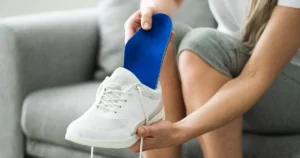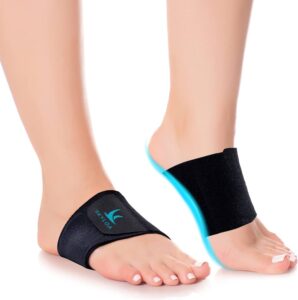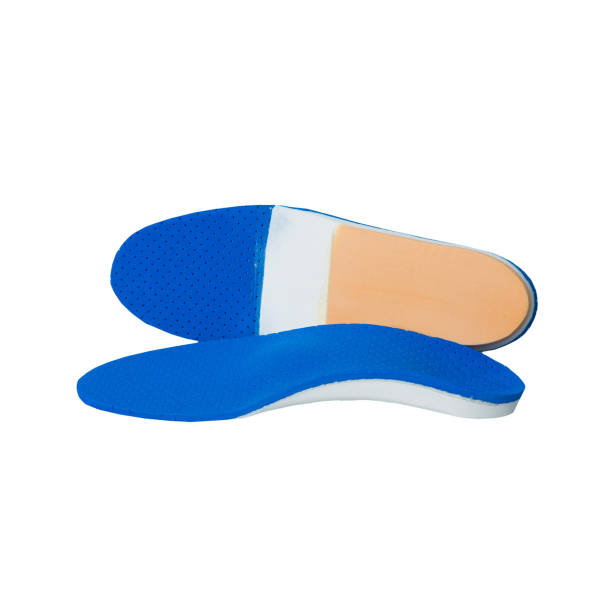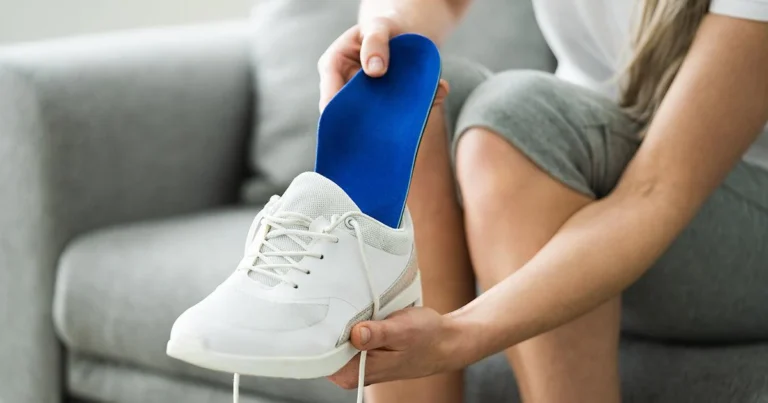In our fast-paced lives, we often overlook the importance of taking care of our feet, specifically the arches. Yet, these often-neglected parts of our body play a crucial role in maintaining our overall well-being. Healthy arches ensure proper balance, stability, and alignment, preventing various foot problems that can have a ripple effect on our entire body. In this article, we will explore essential tips for keeping your arches healthy and happy.
Understanding the Arch of Your Foot
Before we delve into the tips for maintaining healthy arches, let’s briefly understand what the arch of your foot is. The arch is the curved part on the bottom of your foot that spans from the heel to the ball of your foot. It consists of three main parts: the medial arch (inner), the lateral arch (outer), and the transverse arch (across the ball of your foot). These arches work together to support your body weight and absorb shock when you walk or run.
Choose the Right Footwear
Selecting the appropriate footwear is the first step in maintaining healthy arches. Your choice of shoes can significantly impact the well-being of your feet, including the arches. Here are some essential considerations when choosing the right footwear:
1. Arch Support
Look for shoes that offer proper arch support. This support helps distribute your body weight evenly across your feet, reducing stress on the arches. Shoes with built-in arch support or those that allow you to insert orthotic insoles are ideal.
2. Cushioning
Ensure that your shoes provide ample cushioning, especially in the heel and forefoot areas. Cushioning helps absorb shock while walking or running, reducing the impact on your arches.
3. Shoe Type
Consider the type of shoes you need for different activities. For instance, athletic shoes are designed to provide support during physical activities, while casual shoes may not offer the same level of support. Choose the right type of shoe for your intended activity.
4. Proper Fit
Always prioritize a proper fit when buying shoes. Ill-fitting shoes can cause discomfort and put strain on your arches. Ensure that there is enough room for your toes to wiggle, and that the shoe does not squeeze or pinch any part of your foot.
5. Heel Height
Avoid shoes with excessively high heels, as they can alter your foot’s natural alignment and increase pressure on your arches. Opt for shoes with lower, more stable heels for everyday wear.
6. Material
Choose shoes made from breathable materials like leather or mesh. Breathable shoes help prevent moisture buildup, reducing the risk of fungal infections and maintaining overall foot hygiene.
7. Shoe Rotation
Rotate your shoes to give your feet a break. Wearing the same pair of shoes every day can lead to wear and tear on specific areas, including the arch support. Switching between different pairs allows your shoes to recover and maintain their supportiveness.
8. Shoe Shopping
When shopping for shoes, go later in the day when your feet may be slightly swollen, as this mimics the conditions when your feet are most active. This ensures that you choose shoes that fit comfortably even during extended periods of wear.
9. Consult a Specialist
If you have specific arch issues or foot conditions, consider consulting a podiatrist or a footwear specialist. They can provide recommendations tailored to your unique needs.
By paying attention to these factors and choosing the right footwear, you can provide essential support to your arches, promoting their health and overall comfort.
Stretch and Strengthen
Stretching and strengthening exercises are crucial components of maintaining healthy arches. These exercises not only help alleviate tension but also enhance the stability and support of your arches. Here are some effective exercises you can incorporate into your routine:
1. Calf Stretches
Calf stretches are beneficial in preventing arch stiffness and maintaining flexibility in the lower leg. Follow these steps:
- Stand facing a wall with your hands resting on it.
- Take a step back with one foot while keeping it flat on the ground.
- Bend your front knee while keeping your back leg straight.
- Lean forward slightly, feeling the stretch in your calf.
- Hold the stretch for 20-30 seconds and repeat on the other leg.
- Perform this stretch several times a day.
2. Plantar Fascia Stretch
The plantar fascia is the tissue along the bottom of your foot that plays a crucial role in arch support. Stretching it can alleviate arch discomfort:
- Sit down and cross one leg over the other.
- Using one hand, hold your toes and gently pull them towards your shin.
- You should feel a stretch along the arch of your foot.
- Hold the stretch for 20-30 seconds and repeat on the other foot.
- Perform this stretch multiple times daily.
3. Toe Curls
Toe curls strengthen the muscles that support the arch. To do this exercise:
- Sit comfortably in a chair with your feet flat on the ground.
- Gradually curl your toes downward as if you’re trying to grip the floor.
- Hold this position for a few seconds, then relax.
- Repeat this exercise for about 10-15 times on each foot.
4. Arch Raises
Arch raises help strengthen the muscles on the underside of your foot:
- Sit in a chair with your feet flat on the ground.
- Lift your arch by curling your toes while keeping your heel on the ground.
- Hold this position for a few seconds and then release.
- Repeat this exercise 10-15 times on each foot.
5. Towel Scrunches
Towel scrunches are an effective way to work on your arch strength and dexterity:
- Place a small towel on the floor.
- Using your toes, scrunch the towel towards you, forming wrinkles.
- Release and straighten the towel.
- Repeat this motion for a few minutes, trying to create as many wrinkles as possible.
Incorporate these stretching and strengthening exercises into your daily routine to help maintain healthy arches. Remember to start slowly and gradually increase the intensity to avoid overexertion. Over time, these exercises can improve the flexibility and strength of your arches, reducing the risk of arch-related issues.
Maintain a Healthy Body Weight
Maintaining a healthy body weight is essential for the well-being of your arches, as excess weight can place additional stress on these critical structures. Here are some valuable tips to help you achieve and maintain a healthy weight, which in turn supports your arch health:
1. Balanced Diet
Adopting a balanced diet is the cornerstone of achieving and maintaining a healthy body weight. Focus on consuming a variety of nutrient-dense foods, including fruits, vegetables, lean proteins, whole grains, and healthy fats. Limit your intake of sugary beverages, processed foods, and high-calorie snacks.
2. Portion Control
Be mindful of portion sizes to avoid overeating. Use smaller plates, bowls, and utensils to help control portions. Pay attention to hunger and fullness cues to prevent unnecessary calorie consumption.
3. Regular Exercise
Incorporate regular physical activity into your daily routine. Aim for at least 150 minutes of moderate-intensity aerobic exercise or 75 minutes of vigorous-intensity exercise per week. Exercise helps burn calories, improve metabolism, and support overall weight management.
4. Strength Training
Include strength training exercises in your fitness regimen. Building lean muscle mass can boost your metabolism and contribute to long-term weight maintenance. Strength training exercises can range from using resistance bands to lifting weights.
5. Stay Hydrated
Drink plenty of water throughout the day. Sometimes, thirst can be mistaken for hunger, leading to unnecessary snacking. Staying hydrated also supports overall bodily functions and can aid in weight management.
6. Mindful Eating
Practice mindful eating by paying full attention to your meals. Avoid distractions like TV or smartphones while eating, and savor each bite. Eating slowly and mindfully can help prevent overeating.
7. Set Realistic Goals
Set achievable weight loss or weight maintenance goals. Rapid, unsustainable weight loss can be harmful to your overall health. Aim for gradual and steady progress.
8. Get Adequate Sleep
Ensure you get enough quality sleep each night. Lack of sleep can disrupt hormones that regulate hunger and appetite, potentially leading to weight gain.
9. Seek Support
Consider seeking support from a registered dietitian or a weight management program. Professional guidance can provide you with personalized strategies and motivation to reach your weight-related goals.
10. Track Your Progress
Keep a food diary or use a mobile app to track your food intake, physical activity, and progress. Monitoring your habits can help you identify areas for improvement and stay accountable.
Maintaining a healthy body weight is a key factor in preventing excessive stress on your arches. By adopting a balanced lifestyle that includes nutritious eating habits and regular exercise, you can not only support your arch health but also enhance your overall well-being. Remember that achieving and maintaining a healthy weight is a long-term commitment that requires patience and dedication.
Practice Proper Foot Hygiene
Maintaining proper foot hygiene is essential for overall foot health and can significantly contribute to the well-being of your arches. Neglecting foot hygiene can lead to various issues that may affect your arches and overall comfort. Here are some essential tips for practicing proper foot hygiene:
1. Daily Washing
Wash your feet daily with warm water and mild soap. Gently scrub your feet, including the area between your toes and under your nails. This helps remove dirt, sweat, and bacteria that can lead to foot odor and infections.
2. Drying Thoroughly
After washing your feet, pat them dry with a clean towel. Pay close attention to the spaces between your toes, as moisture can accumulate there. Ensure your feet are completely dry before putting on socks and shoes.
3. Moisturize
Apply a moisturizing foot cream or lotion to keep your skin soft and prevent dryness and cracking. Avoid applying moisturizer between your toes, as excessive moisture in this area can lead to fungal infections.
4. Trim Toenails Carefully
Trim your toenails straight across and avoid cutting them too short. This reduces the risk of ingrown toenails, which can be painful and affect your arch support.
5. Maintain Good Toenail Hygiene
Clean under your toenails regularly to remove dirt and prevent the buildup of debris. A nail brush or a soft toothbrush can be useful for this purpose.
6. Choose Breathable Footwear
Opt for shoes made from breathable materials, such as leather or mesh. Breathable shoes help prevent moisture buildup and reduce the risk of fungal infections.
7. Rotate Shoes
Avoid wearing the same pair of shoes every day. Rotate your shoes to allow them to air out and prevent odor and fungal growth. Using moisture-wicking insoles can also help keep your feet dry.
8. Use Foot Powder
If you tend to sweat excessively, consider using foot powder or antiperspirant on your feet to reduce moisture and odor.
9. Wear Clean Socks
Change your socks daily, especially if you have been active or your feet have become sweaty. Choose moisture-wicking socks that help keep your feet dry.
10. Protect Your Feet in Public Areas
When using communal showers, swimming pools, or locker rooms, wear flip-flops or waterproof sandals to protect your feet from infections, such as athlete’s foot.
11. Address Foot Issues Promptly
If you notice any foot problems, such as blisters, corns, calluses, or signs of infection, seek prompt treatment from a healthcare professional or podiatrist.
Proper foot hygiene is a simple yet effective way to maintain the health of your arches and reduce the risk of foot-related issues. By incorporating these practices into your daily routine, you can ensure that your feet remain comfortable, clean, and free from potential complications.
Use Custom Orthotics
Custom orthotics are specialized shoe inserts designed to provide personalized arch support and alignment for your feet. They can be a valuable tool in maintaining healthy arches, especially if you have specific arch problems or conditions. Here’s what you need to know about custom orthotics:
1. Personalized Support
Custom orthotics are created to match the unique contours of your feet. A podiatrist or orthopedic specialist will take precise measurements and molds of your feet to design orthotics that address your specific arch issues.
2. Arch Conditions
Custom orthotics can be beneficial for individuals with various arch-related conditions, including:
- Flat Feet: Custom orthotics can provide the necessary arch support for individuals with flat feet, helping to distribute pressure evenly across the feet.
- High Arches: For those with high arches, custom orthotics can help cushion and support the arch, reducing the risk of arch strain and pain.
- Plantar Fasciitis: Custom orthotics can alleviate the symptoms of plantar fasciitis by providing targeted support to the plantar fascia, the tissue along the bottom of the foot.
- Overpronation and Supination: Orthotics can help correct issues with foot alignment, such as overpronation (inward rolling of the foot) or supination (outward rolling), to maintain proper arch stability.
3. Improved Comfort
Custom orthotics are designed to fit comfortably in your shoes, providing support without causing discomfort or friction. They can be worn in various types of footwear, including athletic shoes, casual shoes, and even dress shoes.
4. Preventative Measure
Even if you don’t have any existing arch problems, custom orthotics can serve as a preventative measure to maintain healthy arches. They can help distribute pressure evenly and reduce the risk of developing arch-related issues in the future.
5. Professional Consultation
To get custom orthotics, consult a podiatrist or orthopedic specialist. They will assess your foot structure, gait, and any existing issues to determine whether custom orthotics are necessary. If recommended, they will take the necessary measurements and order the orthotics tailored to your needs.
6. Maintenance
Custom orthotics may require periodic adjustments or replacements, depending on wear and tear. Follow your healthcare professional’s guidance on maintenance and replacement schedules to ensure their continued effectiveness.
Custom orthotics can be a valuable investment in maintaining the health and comfort of your arches. They provide tailored support and can alleviate or prevent various arch-related problems. If you experience discomfort or have concerns about your arches, consult a healthcare professional to explore the benefits of custom orthotics for your unique foot structure.
Gradual Increase in Activity
When it comes to maintaining healthy arches and overall foot health, it’s essential to avoid sudden spikes in physical activity. Gradually increasing your activity level can help your arches adapt to the added stress and reduce the risk of strain or injury. Here’s why and how to implement a gradual increase in activity:
1. Prevent Overuse Injuries
Sudden, intense physical activity can strain your arches and the supporting muscles, ligaments, and tendons. This can lead to overuse injuries like plantar fasciitis or arch pain. By gradually increasing your activity level, you give your arches time to adjust and strengthen, reducing the risk of such injuries.
2. Allow Adaptation
Your body needs time to adapt to increased physical demands. When you start a new exercise routine or intensify your current one, your arches may not be accustomed to the added stress. Gradual increases allow your arches to build strength and resilience over time.
3. Listen to Your Body
Pay attention to your body’s signals. If you experience discomfort, pain, or signs of overexertion in your arches, it’s crucial to take a step back and allow time for recovery. Pushing through pain can exacerbate arch problems and lead to more severe injuries.
4. Follow a Plan
Create a structured plan for increasing your physical activity. Whether it’s walking, running, or engaging in sports, start at a comfortable level and slowly progress. For example, if you’re starting a running routine, begin with short distances and low intensity, then gradually increase the distance and intensity over weeks or months.
5. Warm-Up and Cool Down
Prioritize warm-up and cool-down routines in your exercise regimen. Warm-up exercises prepare your muscles and arches for activity, while cool-down exercises help with recovery and reduce post-exercise discomfort.
6. Rest Days
Incorporate rest days into your schedule to allow your arches and body to recover. Rest is a vital component of any exercise routine and gives your arches time to heal and adapt.
7. Footwear Matters
Ensure you’re wearing appropriate footwear for your chosen activity. Shoes that provide arch support and cushioning can help reduce the stress on your arches during exercise.
8. Consult a Professional
If you’re uncertain about how to safely increase your activity level or if you have pre-existing arch issues, consider consulting a physical therapist or podiatrist. They can provide guidance on the best exercises and progression tailored to your specific needs.
9. Be Patient
Remember that progress takes time. Avoid rushing into intense physical activity and prioritize the long-term health of your arches over short-term gains. Gradual improvements will lead to stronger, more resilient arches.
By implementing a gradual increase in activity, you can protect the health of your arches and enjoy physical activities with reduced risk of injuries. Patience and a structured approach to fitness will ultimately contribute to the longevity and strength of your arches.
Foot Massages
Regular foot massages can be a delightful and effective way to maintain the health of your arches and promote overall foot comfort. Foot massages offer numerous benefits, including relaxation, improved circulation, and relief from arch-related discomfort. Here’s how to enjoy the benefits of foot massages:
1. Increased Blood Circulation
Foot massages stimulate blood flow to your arches and feet, which can help reduce swelling and inflammation. Improved circulation also aids in delivering essential nutrients and oxygen to the tissues in your arches, promoting their health.
2. Muscle Relaxation
Arch muscles can become tense and fatigued due to daily activities or exercise. Foot massages work to relax these muscles, relieving tension and reducing the risk of muscle strains in your arches.
3. Pain Relief
If you experience arch pain or discomfort, a foot massage can provide temporary relief by releasing endorphins and soothing the nerves in your feet. Regular massages can help manage chronic arch pain associated with conditions like plantar fasciitis.
4. Stress Reduction
Foot massages are incredibly relaxing and can reduce overall stress levels. This relaxation extends to your arches, as less tension in your body can contribute to healthier feet.
5. DIY Foot Massage
You can perform a simple foot massage at home using your hands or a tennis ball:
- Sit comfortably in a chair.
- Apply lotion or massage oil to your feet to reduce friction.
- Use your thumbs to knead your arches, applying gentle pressure.
- Work your way from the heel to the ball of your foot in circular motions.
- Pay extra attention to any sore spots or tension in your arches.
- You can also roll a tennis ball under your foot by placing it on the ground and rolling it back and forth.
6. Professional Massage
Consider getting a professional foot massage from a trained massage therapist. They have the expertise to target specific areas of your arches and feet, providing a more comprehensive and relaxing experience.
7. Frequency
The frequency of foot massages depends on your needs and preferences. You can enjoy a brief foot massage daily or indulge in longer sessions a few times a week. Listen to your body, and schedule massages as needed for relaxation and pain relief.
8. Complement with Warm Soaks
Enhance the benefits of foot massages by soaking your feet in warm water before the massage. This can help relax your muscles and prepare your arches for a more effective massage.
9. Consult a Professional
If you have chronic arch pain or a specific foot condition, consult a podiatrist or physical therapist before starting any foot massage routine. They can provide guidance on the best massage techniques for your unique needs.
Incorporating foot massages into your self-care routine can be a soothing and enjoyable way to maintain the health and comfort of your arches. Whether you choose to do it yourself or seek the expertise of a professional, regular foot massages can contribute to happier and healthier feet.
Arch-Friendly Work Shoes
If your job requires long hours of standing or walking, selecting the right footwear is essential to support your arches and maintain overall foot comfort. Arch-friendly work shoes can make a significant difference in preventing arch-related discomfort and pain. Here’s what to consider when choosing work shoes that prioritize arch support:
1. Arch Support
Look for work shoes that offer substantial arch support. Arch support helps distribute your body weight evenly across your feet, reducing stress on the arches. Shoes with built-in arch support or those that allow you to insert custom orthotic insoles are ideal.
2. Cushioning
Ensure that your work shoes provide ample cushioning, especially in the heel and forefoot areas. Good cushioning helps absorb shock while standing or walking, reducing the impact on your arches and minimizing fatigue.
3. Proper Fit
Choose work shoes that fit correctly. Ill-fitting shoes can cause discomfort and put unnecessary strain on your arches. Ensure there is enough room for your toes to move and that the shoes do not pinch any part of your foot.
4. Shoe Type
Consider the type of work shoes you need based on your job requirements. Different professions may necessitate specific shoe features. For example:
- Nursing or Healthcare: Look for comfortable and supportive nursing shoes designed for long hours on your feet.
- Retail: Opt for shoes that offer both style and support for prolonged standing.
- Industrial or Construction: Ensure that your work boots provide excellent arch support and protection for heavy-duty tasks.
5. Slip-Resistant Soles
If your workplace may have slippery surfaces, select work shoes with slip-resistant soles. These soles provide added traction and stability, reducing the risk of falls and potential arch injuries.
6. Breathable Materials
Choose work shoes made from breathable materials like leather or mesh. Breathable shoes help prevent moisture buildup and maintain foot hygiene, reducing the risk of fungal infections.
7. Shock Absorption
Look for shoes with effective shock absorption technology in the soles. These features can help reduce the impact on your arches and minimize discomfort, especially on hard surfaces.
8. Shoe Rotation
Consider having multiple pairs of work shoes and rotate them regularly. This allows your shoes to air out and recover, ensuring they maintain their supportiveness and cushioning.
9. Insoles
If your work shoes lack sufficient arch support, consider using custom orthotic insoles. These inserts can provide personalized support and alignment, reducing the risk of arch-related issues.
10. Consult a Specialist
If you have specific arch problems or foot conditions, it’s advisable to consult a podiatrist or footwear specialist. They can recommend work shoes tailored to your unique needs.
Investing in arch-friendly work shoes is an investment in your overall foot health and comfort. By selecting the right footwear for your job, you can help prevent arch-related discomfort, reduce the risk of injuries, and ensure that you stay comfortable and productive throughout your workday.
Avoid Prolonged Standing
Prolonged standing, especially on hard surfaces, can place significant stress on your arches and feet, leading to discomfort, fatigue, and potential health issues. Whether your job or daily activities require you to be on your feet for extended periods, it’s essential to take measures to avoid the negative effects of prolonged standing:
1. Frequent Breaks
If your job involves standing for long hours, schedule regular breaks to allow your arches and feet to rest. Even short breaks to sit down and elevate your feet can help alleviate the strain.
2. Shift Your Weight
While standing, shift your weight from one foot to the other periodically. This can help distribute the pressure more evenly across your feet and reduce localized stress on your arches.
3. Use Anti-Fatigue Mats
If you work in an environment where prolonged standing is necessary, such as in a kitchen or retail setting, consider using anti-fatigue mats. These mats provide cushioning and support, reducing the impact on your arches and improving comfort.
4. Wear Supportive Shoes
Invest in comfortable and supportive shoes designed for prolonged standing. Look for shoes with adequate arch support and cushioning to reduce the strain on your feet.
5. Compression Socks
Consider wearing compression socks or stockings, which can help improve blood circulation in your legs and reduce swelling in your feet and ankles, thereby reducing discomfort during prolonged standing.
6. Maintain Good Posture
Pay attention to your posture while standing. Stand up straight with your weight evenly distributed between both feet. Avoid locking your knees, as this can lead to more discomfort.
7. Foot Exercises
Perform simple foot exercises during breaks to keep your feet active and alleviate strain. Flex and point your toes, roll your ankles, and perform gentle calf raises to promote circulation and reduce tension.
8. Wear Custom Orthotics
If you have specific arch problems or conditions, consult a podiatrist for custom orthotic inserts. These can provide personalized arch support and alignment, reducing the strain on your arches during prolonged standing.
9. Use a Footrest
If possible, use a footrest or a footstool to elevate one foot at a time briefly. This can help reduce pressure on your arches and improve overall comfort.
10. Stretch Regularly
Stretch your calf muscles and the plantar fascia during breaks and after work. Stretching can help maintain flexibility and relieve tension in your arches.
11. Proper Flooring
If you have control over your workspace, consider using ergonomic flooring that provides cushioning and support, reducing the impact on your arches.
12. Consult a Specialist
If you experience chronic discomfort or pain due to prolonged standing, consult a healthcare professional or a podiatrist. They can provide guidance on managing and mitigating the effects of standing-related issues.
Taking steps to avoid prolonged standing and implementing strategies to reduce the strain on your arches can significantly improve your comfort and long-term foot health. Prioritizing your arches’ well-being is essential, especially if standing is a regular part of your daily routine.
Regular Check-Ups
Regular check-ups with a healthcare professional or a podiatrist are essential for maintaining the health of your arches and overall foot well-being. These routine examinations can help identify potential issues early, prevent problems, and ensure that your feet remain in optimal condition. Here’s why regular check-ups are crucial:
1. Early Detection
Regular check-ups allow healthcare professionals to detect any potential arch-related problems or foot conditions at an early stage. Conditions like plantar fasciitis, arch strain, or bunions can be managed more effectively when identified early, preventing them from worsening.
2. Personalized Assessment
During a check-up, a podiatrist can provide a personalized assessment of your foot structure, gait, and any existing issues. They can tailor advice and recommendations to address your specific arch and foot health needs.
3. Custom Orthotics
If you require arch support or custom orthotic insoles, a podiatrist can prescribe and create them based on your unique foot structure. Custom orthotics can help prevent or alleviate arch-related discomfort.
4. Professional Guidance
Regular check-ups offer an opportunity to consult with a foot specialist who can provide guidance on proper footwear, exercises, and lifestyle changes that can benefit your arch health. They can recommend arch-friendly shoes and exercises to support your feet.
5. Prevention
Preventive care is a key aspect of regular check-ups. Healthcare professionals can offer advice on how to prevent arch problems and injuries, such as providing strategies for maintaining a healthy body weight and avoiding overuse.
6. Diabetes Management
For individuals with diabetes, regular check-ups are even more crucial. Diabetes can lead to neuropathy and circulation issues that affect foot health. Regular monitoring can help prevent and manage diabetic foot problems.
7. Addressing Pain or Discomfort
If you experience pain or discomfort in your arches or feet, regular check-ups provide an opportunity to address these issues promptly. A healthcare professional can diagnose the cause and recommend appropriate treatment.
8. Monitoring Progress
For individuals undergoing treatment or rehabilitation for arch-related issues, regular check-ups allow healthcare professionals to monitor progress and make necessary adjustments to treatment plans.
9. Foot Hygiene
Podiatrists can also provide guidance on proper foot hygiene and care during check-ups, helping you maintain the cleanliness and health of your feet.
10. Overall Well-Being
Foot health is closely connected to overall well-being. Regular check-ups ensure that your feet are not contributing to issues in other parts of your body, such as knee, hip, or lower back pain.
The frequency of check-ups may vary based on your age, health status, and specific foot concerns. It’s advisable to consult with a healthcare professional to determine an appropriate schedule for your regular foot check-ups. By prioritizing these appointments, you can take proactive steps to maintain the health of your arches and enjoy a more comfortable and active lifestyle.
Conclusion
Maintaining healthy arches is essential for overall foot health and well-being. By following these everyday tips, you can ensure that your arches stay strong, supportive, and pain-free. Remember, your feet are the foundation of your body, and taking care of them is a step toward a healthier, happier you.
Frequently Asked Questions (FAQs)
1. How do I know if I have arch problems?
If you experience persistent foot pain, especially in the arch area, it’s advisable to consult a podiatrist. They can assess your arches and recommend appropriate treatments or orthotics.
2. Can high heels cause arch problems?
Yes, wearing high heels regularly can lead to arch issues. They can put excessive pressure on the arch and may lead to conditions like plantar fasciitis.
3. Are flat feet a significant concern for arch health?
Flat feet can be a concern, as they lack the natural arch support. Custom orthotics or supportive footwear can help individuals with flat feet maintain arch health.
4. How often should I replace my athletic shoes for better arch support?
Athletic shoes should be replaced every 300-500 miles or every 6-12 months, depending on your activity level. Worn-out shoes can provide inadequate arch support.
5. Are there any specific exercises to strengthen the arches?
Yes, exercises like toe curls, arch raises, and towel scrunches can help strengthen the muscles supporting your arches. Consult a physical therapist for guidance on proper techniques.




















+ There are no comments
Add yours